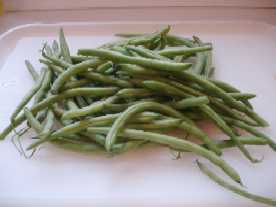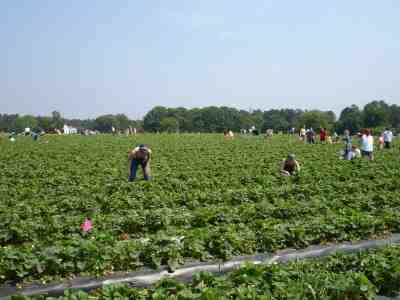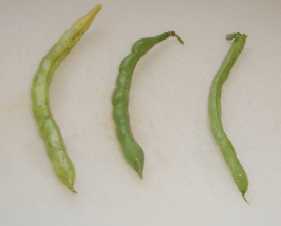
Bean U-Pick Orchards in Dutchess County in Southeast NY in 2024, by county
Below are the U-Pick orchards and farms for beans that we know of in this area. Not all areas of any state, nor even every state, have beans orchards that are open to the public. If you know of any others, please tell us using the add a farm form!
Remember to always check with the farm's own website or Facebook page before you go - or call or email them if they don't have a website or Facebook page. Conditions at the farms and crops can change literally overnight, so if you want to avoid a wasted trip out there - check with the farm directly before you go! If I cannot reach them, I DON'T GO!
PLEASE report closed farms, broken links and incorrect info using the "Report Corrections" form below.
Dutchess County
- Barton Orchards - Apples, pumpkins, tomatoes, cucumbers, eggplant, peppers, beans, squash, peppers, hayrides, petting zoo, haunted house, corn maze
63 Apple Tree Lane, Poughguag, NY 12570. Phone: (845) 227-2306. Email: bartonorchards12570@gmail.com. Open: Monday to Friday from 9:00 am to 5:00 pm, Saturday 9:00 am to 600 pm, Sunday 9:00 am to 6:00 pm, market open year round, apple & pumpkin picking through October 31st, they also have what they call Harvest Festivals in the Fall. Directions: Located in Poughquag, New York. Click here for a map and directions.
Barton Orchards Facebook page. . . In addition to the PYO, they have free hayrides, concessions stands, a food/grocers market (they have the best apple cider doughnuts, and pumpkin pies), Fall /Halloween novelties & mums for sale, petting zoo, a live band on the weekends, haunted house, corn maze, field of screams (during evenings, and activities/rides for children for a small fee. For more information, see these pages: Harvest schedule, Events, Apple varieties, Harvest fun, Photos, Field of Screams, Directions, School tours, Birthday parties .Barton Orchards is . We got our start as an apple farm and have expanded our orchard over the years. Here at, we grow a wide variety of crops. Our crop rotation varies depending on the season. You can pick everything from apples, tomatoes, cucumbers, eggplant, peppers, beans, squash and pumpkins! During apple season, we offer pick your own apples. Apple season is from the middle of August to November. Certain apples will be available for picking depending on when you come for a visit. Be sure to check out our PYO page for what is available for picking. - Fishkill Farms - CERTIFIED ORGANIC, apples, apricots, beans, beets, blackberries, blueberries, broccoli, carrots, cherries, cucumbers, currants (red and black), eggplant, flowers, lavender, melons, nectarines, oranges, pears, peaches, peppers, plums, raspberries (red), raspberries (Spring, red), summer squash, winter squash, strawberries, tomatoes, other vegetables, watermelons, Fresh eggs, Cider mill (fresh apple cider made on the premises), concessions or refreshment stand, porta-potties are available, picnic area, picnic area you may bring your own food, farm animals, birthday parties, school tours, group reservations
9 Fishkill Farm Rd, Hopewell Junction, NY 12533. Phone: (845) 897-4377. Email: info@fishkillfarms.com. Open: hours, days and dates. Directions: Fishkill Farms is located in Dutchess County in the Hudson Valley, just over an hour north of New York City. Take the Taconic Parkway to I-84 East and get off at Exit 15. . Click here for a map and directions. Payment: Cash, Check, Debit cards, Visa, MasterCard, Discover, AmEx.
Fishkill Farms Facebook page. . Early June - Late October Everyday* 9am to 5pm *while supplies lasts. Click here for current open Picking updates: Click here for picking updates. For a map to our farm, Early June: Strawberries and sugar snap peas June-Late September: Vegetables July-August: Flowers Mid July: Cherries July: Raspberries and Blackberries August: Peaches and Nectarines, Tomatoes and Eggplant Mid August-Late October: Apples Early September: Sunflowers September-October: Pumpkins. All vegetables, berries, eggs and 1/3rd of our orchard are certified organic by NOFA NY. is a historic 270-acre farm located in the beautiful Hudson Valley region. Our mission is to grow fresh and flavorful produce for our local community, using holistic farming practices. Our produce is available through pick-your-own, farmers markets, our CSA program, and restaurants. Our farm store is open year-round, 7 days a week from 9am-6pm offering apple cider donuts, fresh-baked pies, artisanal meats & cheeses, locally produced wines beers, liquors and hard cider.Fishkill Farms is one of the oldest and most historic orchards in the Hudson Valley. Varieties of New York Apples: Macintosh, Red Delicious, Spartan, Empire, Macoun, Golden Delicious, Red Delicious, and Rome. We charge a $5 admission fee for fruit and vegetable picking for adults and children over the age of 12.
Oops! Error
Green Bean, Lima Bean, Shelled Beans Picking Tips, Recipes and Information
When are fresh beans available?
Beans are a warm weather crop, and won't grow much in cold soil. It takes them about 60 to 70 days from seed to harvest.
In the U.S. beans typically peak in harvesting from June through October in the South, and in July to September in the North. But they can be ready as early as early June in many places, if the weather is good.
Before you leave to go to the farm:
- Always call before you go to the farm - it's hard to pick in a muddy field!
- Most growers furnish picking containers designed for beans, but they may charge you for them; be sure to call before you go to see if you need to bring containers.
- Bring something to drink and a few snacks; you'd be surprised how you can work up a thirst and appetite! And don't forget hats and sunscreen for the sun. Bugs usually aren't a problem, but some deet might be good to bring along if it has been rainy.
Tips on How to Pick Beans
Whether you pick beans from your garden or at a Pick-Your-Own farm, here are a few tips to keep in mind.
Tips on How to Pick Green Beans
- Most beans these days are "stringless". That refers to a string, tough filament of the bean that runs along the outside from one end to the other. Some beans have two, one on each side; and some have one.
- I prefer to snap the bean off the plant just below where the stem attaches to the bean. If you do this, it will save time when you get home, because one end of the bean has already been trimmed. But this only makes sense if you will be using, cooking, canning or freezing the beans that day.
- If you won't be using the beans the same day, then break off the bean from the plant along the thin stem that connects the bean to the plant.
- The beans snap off pretty easily. hence the name "snap beans".
- Pole beans are the easiest to pick, because, since they grow up poles or twine, you don't have to squat down or bend over!
- Beans are ready for harvest when the pods are plump and firm, but not yet bulging. .
- In your own garden, pick your beans regularly to encourage more growth and prevent the pods from becoming tough and stringy.
- To harvest, hold the stem of the plant with one hand and gently snap the pod with the other..
Look for string, snap or green beans that are :
-
firm

- green (not yellowish - unless you're picking yellow beans!)
- smooth, not wrinkly on the surface - that's an old or dried out bean. Snap beans are best when the pods are firm and snap readily, but before the seeds within the pod develop. The tips should be pliable
- not lumpy - those lumps are the beans that are developed - that's an overripe green bean! Of course, if you want mature beans (not including the pod) then that's a different story, but we're talking about green beans here).
-
The beans in the photo at right are, from left:
- old and yellowing,
- overripe and lumpy; and
- dried out and damaged. - Avoid placing the picked beans in the sunlight any longer than necessary. It is better to put them in the shade of a tree or shed than in the car trunk or on the car seat. Cool them as soon as possible after picking. I prefer to bring a cooler with ice in it. Green Beans may be kept fresh in the refrigerator for 3 or 4 days
When you get home
- After harvesting, store your beans in the refrigerator or blanch and freeze them for longer storage.
- Put them in the vegetable crisper in the fridge, in a loose plastic bag.
- They will be good for about a week like that.
Bean recipes and home canning
Now, get ready to can or freeze the extra beans - It is VERY easy! Click on the links for easy instructions.
- How to can green beans, yellow beans, snap beans, broad beans, etc.
- How to make pickled beans
- How to freeze green beans (and other beans)
- How to Freeze Lima Beans, Broad beans, Butter Beans and/or Pinto Beans
- Canning fresh shelled beans
- Canned dried beans and peas (from kidney beans, peas, lima beans, broadbeans, chickpeas, pole beans, etc.)
- Canned Baked Beans With Tomato or Molasses Sauce
- Canned Baked Beans With Back, Pork or Ham and Tomato or Molasses Sauce -
- Pickled green beans
- Pickled Dill beans
- Mustard beans (pickled mustard beans)
- Pickled Three-Bean Salad
Varieties
There are many different types of beans, each with their own unique flavor, texture, and growing requirements. Some of the most popular varieties include:
- Green Beans: Also known as snap beans or string beans, green beans are a classic garden staple. They can be eaten fresh or cooked and come in bush and pole varieties.
- Lima Beans: Lima beans (called Broad Beans or Butter Beans in the UK) are a nutritious and protein-rich vegetable that can be eaten fresh or dried. They require a long growing season and prefer warm temperatures.
- Pole Beans: Pole beans are a climbing variety of bean that require support to grow. They can reach up to 10 feet tall and have a longer growing season than bush beans.
- Dried Beans: Dried beans are a versatile pantry staple that can be used in soups, stews, and other dishes. Popular varieties include black beans, navy beans, kidney beans, black beans, garbanzo (aka, chick peas) and pinto beans
- s, navy beans, kidney beans, black beans, garbanzo (aka, chick peas) and pinto beans
Other Local Farm Products (Honey, Horses, Milk, Meat, Eggs, Etc.)
(NOT pick-your-own, unless they are also listed above)
- Farm markets and roadside stands
- Local Honey Finder
- Local Meat, Milk and Eggs
- Venues: Farms, Wineries, Orchards for your event, wedding or party
- Easter egg hunts
- Children"s consignment sales
- Fruit and vegetable festivals
- Winery tours and wine tastings
- Horse rides, stables, lessons, trails
- Maple Syrup farms and sugarworks
- Bed & Breakfasts on Farms, Wineries, Ranches and Orchards
- Pumpkin patches
- Corn mazes
- Zombie Paintball venues
- Christmas Tree Farms & lots
- Environmental resources
- Consumer fraud information
- Wholesale food sources
- Resources for Farmers
Looking for canning equipment and supplies?
Water bath canner with a jar rack
Pressure canners for gas, electric and induction stoves: Presto 23Qt or T-fal 22Qt
Canning scoop (this one is PERFECT)
Ball Blue book (most recent version)
Find Other types of farms:
- Easter egg hunts
- Children's consignment sales
- Farm markets and roadside stands
- Road trips and camping resources
- Local Honey, apiaries, beekeepers
- Local Meat, Milk and Eggs
- Consumer fraud and scams information
- Home canning supplies at the best prices on the internet!
- Maple Syrup Farms, sugarworks, maple syrup festivals
- Environmental information and resources
- Farms For Your Event for birthday parties, weddings, receptions, business meetings, retreats, etc.
- Festivals - local fruit and vegetable festivals
- Pumpkin patches and corn mazes
- Christmas Tree Farms and lots
Get the
most recent version of
the Ball Blue Book
Get the
most recent version of
the Ball Blue Book of Home Canning
Find other types of farms:
- Easter egg hunts
- Children's consignment sales
- Farm markets and roadside stands
- Local Honey
- Local Meat, Milk and Eggs
- Road trip and camping
- Pumpkin patches and corn mazes
- Christmas Tree Farms and lots
- Maple Syrup farms and sugarworks
Highly rated canning supplies:
- Regular Mouth Canning Lids with food-grade with BPA Free Silicone seals for Ball, Kerr Jars for Canning
- Canning accessories kit: funnel, jar tongs, lid lifter, etc
- Food Dehydrator, 400W Electric with 8 Trays, 48 hour Timer and Temperature Control 95-176℉, BPA-Free
- Water Bath Canner, 21 Qts with lid, Jar Rack, Speckled Black, cans 7 quart jars, 9 pint jars or 13 half-pint jars
- Air Fryer: Instant Pot Instant Vortex Plus XL 8QT Clear Windows, Custom Programming, 8-in-1
fruit dehydrator, Crisps, Broils, Roasts, Bakes, Reheats
- Pressure canner: All American 921, 21.5qt Pressure Cooker/Canner, never needs gaskets, Great for Gas, Electric or Flat Top Stoves - Made in the USA
- The Backyard Homestead: a guide to homesteading , on 1/4 acre, how to raise grains and vegetables; raise animals for meat, eggs, and dairy; and keep honey bees
- HEPA Air Purifiers for Home, Large Rooms for Allergies, Smoke, Pets. QUIET, Eliminates 99.97% of Dust, Pet Hair, Odors


